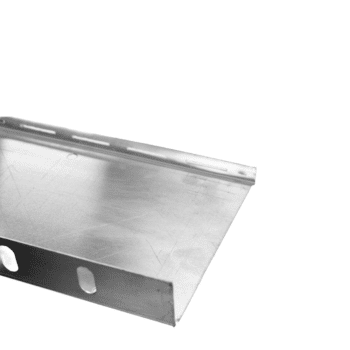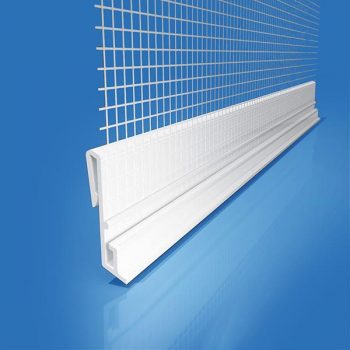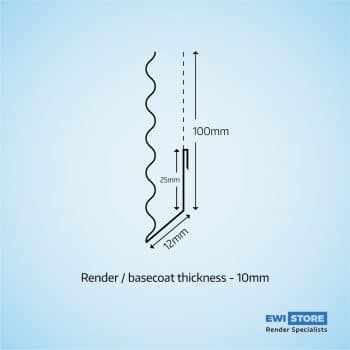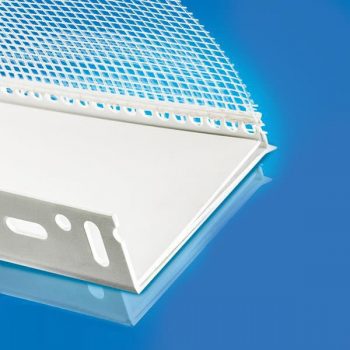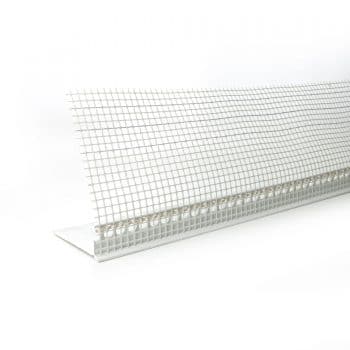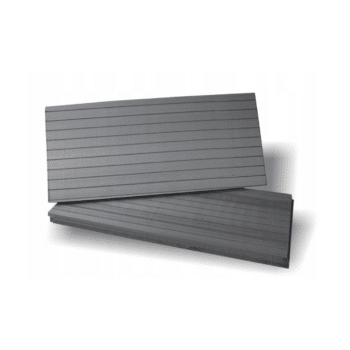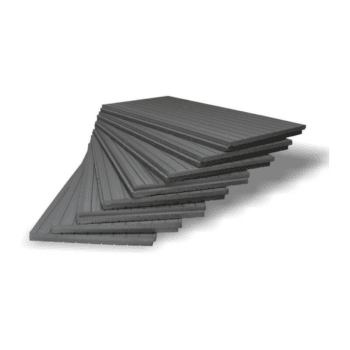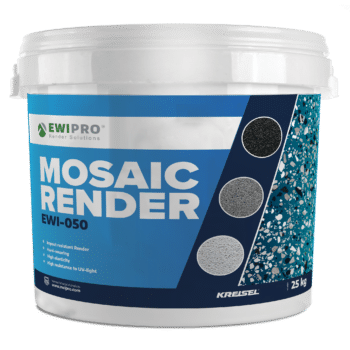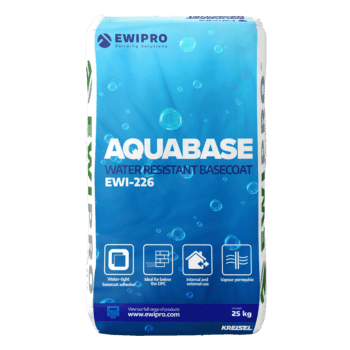How to use an Insulation Starter Track?
Installing insulation in your home can be daunting, especially if you’re doing it for the first time. However, with the right tools and techniques, you can effectively insulate your space to improve energy efficiency and comfort. One essential tool in installing external wall insulation is the insulation starter track.
What is an insulation starter track?
An insulation starter track is essential in installing external wall insulation systems. It provides a precise baseline and secure anchoring point for the insulation boards applied to a building’s exterior walls. Starter tracks ensure the insulation is installed correctly and performs effectively over time. Two primary materials commonly used for these tracks are uPVC and aluminium. Each offers distinct benefits depending on the specific requirements of the insulation project.
uPVC insulation starter tracks
uPVC, or unplasticised polyvinyl chloride, is a popular material for insulation starter tracks due to its durability and resistance to weather conditions. uPVC tracks are lightweight, making them easy to handle and install. They are also resistant to moisture and decay. This is particularly important in maintaining the integrity of the building’s insulation in damp climates.
One of the key advantages of uPVC starter tracks is their readiness. Unlike the aluminium starter tracks, they come with mesh, having a different overall profile. Therefore, they do not require a clip-on profile. Additionally, uPVC is not prone to corrosion. Corrosion can be an issue in coastal areas or places with high levels of air pollution.
Aluminium insulation starter tracks
Aluminium starter tracks are favoured for their strength and rigidity, making them ideal for commercial projects or buildings requiring higher structural integrity. This lightweight metal offers excellent durability and is completely immune to rust and corrosion, ensuring a long lifespan even under harsh environmental conditions.
Aluminium tracks can bear heavier loads than uPVC, making them suitable for supporting thicker, denser insulation boards. This property is particularly beneficial in high-rise buildings or areas with extreme weather conditions where the insulation system must withstand significant wind loads.
Clip-on profiles are designed to enhance and finish external wall insulation systems with aluminium starter tracks. These profiles are engineered to clip easily onto the aluminium tracks, providing a seamless and aesthetically pleasing finish at the base of the insulated wall.
The primary function of the clip-on profile is to ensure a neat edge where the insulation terminates. Still, it also incorporates a critical design feature, a drip nose. Therefore, the drip nose plays a vital role in moisture management by directing water away from the wall. As water runs down the surface of the render, the dripping nose ensures that it is channelled away from the wall. This significantly reduces the risk of water ingress and potentially damp issues.
This addition not only improves the visual continuity and neatness of the installation but also enhances the overall performance of the insulation system by preventing moisture-related complications. By integrating clip-on profiles with aluminium starter tracks, the system provides robust protection against the elements, ensuring durability and effectiveness in the insulation setup.
-
Premium Aluminium Starter Track (2.5m)
From £7.30 Incl. VATFrom £6.08 Excl. VAT -
10mm Clip-on Profile for Starter Track (2.5m)
From £6.95 Incl. VATFrom £5.79 Excl. VAT -
uPVC Starter Track 60mm-90mm (2m)
£20.39 Incl. VAT£16.99 Excl. VAT
How to install insulation starter track
Step 1: Assess and prepare the substrate
Start by evaluating the substrate to ensure it can support the weight of the insulation and is suitable for installing a starter track. Consider the following:
- Weight Support: Check if the wall can support the weight of the insulation.
- Wall Condition: Determine if the wall is even as uneven walls can complicate the installation of a starter track. You can use shims and packers to create a level surface if the wall is uneven. Applying an EWI-260 Levelling Mortar might be necessary for more significant unevenness, which can address imperfections up to 50mm thick.
Step 2: Locate the Damp-Proof Course (DPC)
Identifying the DPC is vital to protecting your walls from moisture. The starter track should be mounted just above the DPC level to safeguard the underside of the insulation boards from moisture. If insulation extends below the DPC, use water-resistant boards like XPS and a waterproof basecoat like Aquabase. Finally, finish with a Mosaic Render on the outer layer for additional impermeability.
Step 3: Fixing the starter track
Properly securing the starter track is essential for a stable and effective installation:
- Fixings: To ensure a robust installation, use dedicated starter track fixings. These should be placed at no more than 30cm intervals to avoid bending or warping the track.
- Connector Clips: Connector clips seamlessly bridge gaps between track sections.
- Level Installation: Throughout the installation, consistently use a spirit level to maintain an even and precise alignment of the starter track.
- Corner Installation: When wrapping the starter track around corners, cut the track at 45-degree angles to ensure a tight and effective fit.
Insulating below the starter track – insulating the DPC
It’s crucial to install an uninterrupted thermal envelope. This includes the area below the DPC. However, different materials are required for this process due to the problems with moisture. The DPC is a critical barrier designed to prevent moisture from rising through the structure.
Step 1: Correct insulation material
For areas below the DPC, it’s advisable to use Extruded Polystyrene (XPS) insulation. XPS is known for its high moisture resistance and compressive strength, making it ideal for moisture-prone areas. Its rigid nature and ability to resist water uptake ensure that the insulation retains its thermal properties even in damp conditions.
Step 2: Apply a waterproof basecoat
After installing the XPS insulation boards, the next layer should be a waterproof basecoat. A recommended product for this purpose is EWI Pro Aquabase. This basecoat is specifically formulated to provide a robust waterproof layer over the insulation, effectively preventing any moisture penetration that could compromise the wall structure or the insulation itself.
Step 3: Finish with Mosaic Render
Apply a mosaic render as the outermost layer to protect the insulation and the basecoat while also providing an aesthetically pleasing finish. Mosaic Render is decorative and impermeable, creating an additional barrier against moisture ingress. This render type is durable and designed to withstand external weather conditions, offering further protection to the insulated area.
-
XPS Insulation (1 board)
From £20.38 Incl. VATFrom £10.20 Incl. VATFrom £8.50 Excl. VAT -
Mosaic Render (EWI-050) – 25kg
From £91.19 Incl. VATFrom £75.99 Excl. VAT -
Aquabase (EWI-226) – 25kg
£17.22 Incl. VAT£14.35 Excl. VAT£27.50 Incl. VAT£22.92 Excl. VAT
Facebook
Twitter
LinkedIn
Your cart
Trade Account Login

We use cookies on our website to give you the most relevant experience by remembering your preferences and repeat visits. By clicking “Accept All”, you consent to the use of ALL the cookies. However, you may visit "Cookie Settings" to provide personalised consent.
Manage consent
Privacy Overview
This website uses cookies to improve your experience while you navigate through the website. Out of these, the cookies that are categorized as necessary are stored on your browser as they are essential for the working of basic functionalities of the website. We also use third-party cookies that help us analyze and understand how you use this website. These cookies will be stored in your browser only with your consent. You also have the option to opt-out of these cookies. But opting out of some of these cookies may affect your browsing experience.
Necessary cookies are absolutely essential for the website to function properly. These cookies ensure basic functionalities and security features of the website, anonymously.
| Cookie | Duration | Description |
|---|---|---|
| __stripe_mid | 1 year | This cookie is set by Stripe payment gateway. This cookie is used to enable payment on the website without storing any patment information on a server. |
| __stripe_sid | 30 minutes | This cookie is set by Stripe payment gateway. This cookie is used to enable payment on the website without storing any patment information on a server. |
| _GRECAPTCHA | 5 months 27 days | This cookie is set by the Google recaptcha service to identify bots to protect the website against malicious spam attacks. |
| apbct_cookies_test | session | CleanTalk sets this cookie to prevent spam on comments and forms and act as a complete anti-spam solution and firewall for the site. |
| apbct_page_hits | session | CleanTalk sets this cookie to prevent spam on comments and forms and act as a complete anti-spam solution and firewall for the site. |
| apbct_prev_referer | session | Functional cookie placed by CleanTalk Spam Protect to store referring IDs and prevent unauthorized spam from being sent from the website. |
| apbct_site_landing_ts | session | CleanTalk sets this cookie to prevent spam on comments and forms and act as a complete anti-spam solution and firewall for the site. |
| apbct_site_referer | 3 days | This cookie is placed by CleanTalk Spam Protect to prevent spam and to store the referrer page address which led the user to the website. |
| apbct_timestamp | session | CleanTalk sets this cookie to prevent spam on comments and forms and act as a complete anti-spam solution and firewall for the site. |
| apbct_urls | 3 days | This cookie is placed by CleanTalk Spam Protect to prevent spam and to store the addresses (urls) visited on the website. |
| AWSALBCORS | 7 days | This cookie is managed by Amazon Web Services and is used for load balancing. |
| cookielawinfo-checkbox-advertisement | 1 year | Set by the GDPR Cookie Consent plugin, this cookie is used to record the user consent for the cookies in the "Advertisement" category . |
| cookielawinfo-checkbox-analytics | 11 months | This cookie is set by GDPR Cookie Consent plugin. The cookie is used to store the user consent for the cookies in the category "Analytics". |
| cookielawinfo-checkbox-functional | 11 months | The cookie is set by GDPR cookie consent to record the user consent for the cookies in the category "Functional". |
| cookielawinfo-checkbox-necessary | 11 months | This cookie is set by GDPR Cookie Consent plugin. The cookies is used to store the user consent for the cookies in the category "Necessary". |
| cookielawinfo-checkbox-others | 11 months | This cookie is set by GDPR Cookie Consent plugin. The cookie is used to store the user consent for the cookies in the category "Other. |
| cookielawinfo-checkbox-performance | 11 months | This cookie is set by GDPR Cookie Consent plugin. The cookie is used to store the user consent for the cookies in the category "Performance". |
| ct_checkjs | session | CleanTalk–Used to prevent spam on our comments and forms and acts as a complete anti-spam solution and firewall for this site. |
| ct_fkp_timestamp | session | CleanTalk sets this cookie to prevent spam on the site's comments/forms, and to act as a complete anti-spam solution and firewall for the site. |
| ct_pointer_data | session | CleanTalk sets this cookie to prevent spam on the site's comments/forms, and to act as a complete anti-spam solution and firewall for the site. |
| ct_ps_timestamp | session | CleanTalk sets this cookie to prevent spam on the site's comments/forms, and to act as a complete anti-spam solution and firewall for the site. |
| ct_sfw_pass_key | 1 month | CleanTalk sets this cookie to prevent spam on comments and forms and act as a complete anti-spam solution and firewall for the site. |
| ct_timezone | session | CleanTalk–Used to prevent spam on our comments and forms and acts as a complete anti-spam solution and firewall for this site. |
| elementor | never | This cookie is used by the website's WordPress theme. It allows the website owner to implement or change the website's content in real-time. |
| viewed_cookie_policy | 11 months | The cookie is set by the GDPR Cookie Consent plugin and is used to store whether or not user has consented to the use of cookies. It does not store any personal data. |
Functional cookies help to perform certain functionalities like sharing the content of the website on social media platforms, collect feedbacks, and other third-party features.
| Cookie | Duration | Description |
|---|---|---|
| __zlcmid | 1 year | This cookie is used by Zendesk live chat and is used to store the live chat ID. |
| bcookie | 2 years | LinkedIn sets this cookie from LinkedIn share buttons and ad tags to recognize browser ID. |
| bscookie | 2 years | LinkedIn sets this cookie to store performed actions on the website. |
| lang | session | LinkedIn sets this cookie to remember a user's language setting. |
| lidc | 1 day | LinkedIn sets the lidc cookie to facilitate data center selection. |
| UserMatchHistory | 1 month | LinkedIn sets this cookie for LinkedIn Ads ID syncing. |
Performance cookies are used to understand and analyze the key performance indexes of the website which helps in delivering a better user experience for the visitors.
| Cookie | Duration | Description |
|---|---|---|
| __utma | 2 years | This cookie is set by Google Analytics and is used to distinguish users and sessions. The cookie is created when the JavaScript library executes and there are no existing __utma cookies. The cookie is updated every time data is sent to Google Analytics. |
| __utmb | 30 minutes | Google Analytics sets this cookie, to determine new sessions/visits. __utmb cookie is created when the JavaScript library executes and there are no existing __utma cookies. It is updated every time data is sent to Google Analytics. |
| __utmc | session | The cookie is set by Google Analytics and is deleted when the user closes the browser. It is used to enable interoperability with urchin.js, which is an older version of Google Analytics and is used in conjunction with the __utmb cookie to determine new sessions/visits. |
| __utmt | 10 minutes | Google Analytics sets this cookie to inhibit request rate. |
| __utmv | 2 years | The __utmv cookie is set on the user's device, to enable Google Analytics to classify the visitor. |
| __utmz | 6 months | Google Analytics sets this cookie to store the traffic source or campaign by which the visitor reached the site. |
| sib_cuid | 6 months | Purechat uses this cookie to send data to purechat.com, to connect visitors to the reservation team and track visitors to stay on portal. |
| SRM_B | 1 year 24 days | Used by Microsoft Advertising as a unique ID for visitors. |
Analytical cookies are used to understand how visitors interact with the website. These cookies help provide information on metrics the number of visitors, bounce rate, traffic source, etc.
| Cookie | Duration | Description |
|---|---|---|
| _ga | 2 years | The _ga cookie, installed by Google Analytics, calculates visitor, session and campaign data and also keeps track of site usage for the site's analytics report. The cookie stores information anonymously and assigns a randomly generated number to recognize unique visitors. |
| _gat_gtag_UA_61069204_2 | 1 minute | Set by Google to distinguish users. |
| _gat_UA-61069204-2 | 1 minute | A variation of the _gat cookie set by Google Analytics and Google Tag Manager to allow website owners to track visitor behaviour and measure site performance. The pattern element in the name contains the unique identity number of the account or website it relates to. |
| _gcl_au | 3 months | Provided by Google Tag Manager to experiment advertisement efficiency of websites using their services. |
| _gid | 1 day | Installed by Google Analytics, _gid cookie stores information on how visitors use a website, while also creating an analytics report of the website's performance. Some of the data that are collected include the number of visitors, their source, and the pages they visit anonymously. |
| _uetsid | 1 day | This cookies are used to collect analytical information about how visitors use the website. This information is used to compile report and improve site. |
| CONSENT | 2 years | YouTube sets this cookie via embedded youtube-videos and registers anonymous statistical data. |
Advertisement cookies are used to provide visitors with relevant ads and marketing campaigns. These cookies track visitors across websites and collect information to provide customized ads.
| Cookie | Duration | Description |
|---|---|---|
| _fbp | 3 months | This cookie is set by Facebook to display advertisements when either on Facebook or on a digital platform powered by Facebook advertising, after visiting the website. |
| ANONCHK | 10 minutes | The ANONCHK cookie, set by Bing, is used to store a user's session ID and also verify the clicks from ads on the Bing search engine. The cookie helps in reporting and personalization as well. |
| fr | 3 months | Facebook sets this cookie to show relevant advertisements to users by tracking user behaviour across the web, on sites that have Facebook pixel or Facebook social plugin. |
| MUID | 1 year 24 days | Bing sets this cookie to recognize unique web browsers visiting Microsoft sites. This cookie is used for advertising, site analytics, and other operations. |
| NID | 6 months | NID cookie, set by Google, is used for advertising purposes; to limit the number of times the user sees an ad, to mute unwanted ads, and to measure the effectiveness of ads. |
| test_cookie | 15 minutes | The test_cookie is set by doubleclick.net and is used to determine if the user's browser supports cookies. |
| uuid | 6 months | MediaMath sets this cookie to avoid the same ads from being shown repeatedly and for relevant advertising. |
| VISITOR_INFO1_LIVE | 5 months 27 days | A cookie set by YouTube to measure bandwidth that determines whether the user gets the new or old player interface. |
| YSC | session | YSC cookie is set by Youtube and is used to track the views of embedded videos on Youtube pages. |
| yt-remote-connected-devices | never | YouTube sets this cookie to store the video preferences of the user using embedded YouTube video. |
| yt-remote-device-id | never | YouTube sets this cookie to store the video preferences of the user using embedded YouTube video. |
| yt.innertube::nextId | never | This cookie, set by YouTube, registers a unique ID to store data on what videos from YouTube the user has seen. |
| yt.innertube::requests | never | This cookie, set by YouTube, registers a unique ID to store data on what videos from YouTube the user has seen. |
Other uncategorized cookies are those that are being analyzed and have not been classified into a category as yet.
| Cookie | Duration | Description |
|---|---|---|
| _clck | 1 year | No description |
| _clsk | 1 day | No description |
| _uetvid | 1 year 24 days | No description available. |
| AnalyticsSyncHistory | 1 month | No description |
| apbct_pixel_url | session | No description |
| apbct_visible_fields_0 | session | No description |
| apbct_visible_fields_1 | session | No description |
| apbct_visible_fields_10 | session | No description |
| apbct_visible_fields_2 | session | No description |
| apbct_visible_fields_3 | session | No description |
| apbct_visible_fields_4 | session | No description |
| apbct_visible_fields_5 | session | No description |
| apbct_visible_fields_6 | session | No description |
| apbct_visible_fields_7 | session | No description |
| apbct_visible_fields_8 | session | No description |
| apbct_visible_fields_9 | session | No description |
| ct_checked_emails | session | No description |
| ct_has_scrolled | session | No description |
| ct_mouse_moved | session | No description |
| ct_screen_info | session | No description |
| ictf_master | never | No description available. |
| li_gc | 2 years | No description |
| m | 2 years | No description available. |
| SM | session | No description available. |
| testinfinitycookie | session | No description |
| woocommerce_show_tax | 7 days | No description available. |
| wp_woocommerce_session_c5ac76b408021294cb56bcc27eddf8a1 | 2 days | No description |


